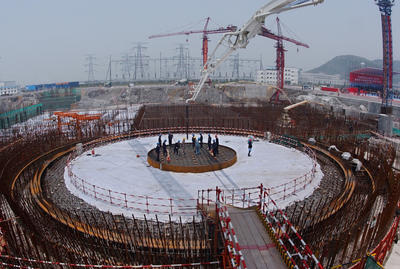The recent Fukushima nuclear crisis is no exception.
As both Japan and China are aware, there is still a long way to go to address the danger and impact of radiation from the Fukushima meltdown. While China is facing many social, economic and environmental challenges of its own, the Chinese government understands that outside events — such as the Arab Spring revolutions or the nuclear crisis in Japan — could spark instability in Chinese society.
Therefore, the Chinese government has repeatedly assured the Chinese public that the radiation from the Fukushima nuclear accident will not have an impact on China and that China’s nuclear facilities are all safe and better managed than those in Japan. The government also underlined the fact that it embraced nuclear power at a point when the technology had been developing in other countries for decades and that therefore China’s own nuclear power plants were established with advanced levels of technology. China’s first domestic nuclear power reactor was officially connected to the grid in 1991.
But still, the prominent place of nuclear energy in China’s energy strategy gives cause for concern. Currently, China has 11 nuclear-power plants connected to the grid. The 20 or so nuclear power plants that are currently being built in China account for 40 per cent of the total amount of the reactors under construction worldwide.
On 16 March, the Chinese government held a high-level State Council meeting to discuss the Japanese nuclear crisis and to consider China’s own nuclear planning. At the meeting the government made three major decisions on nuclear power. First, the government decided to halt its plan to build new nuclear power plants. Second, it ordered a re-examination of the safety risks of the nuclear power stations currently under construction. Any safety faults discovered would lead to construction being stopped. Third, a decision was made to enhance safety measures in nuclear power stations currently in operation in China.
In a rare stand, the Chinese government indicated that the utmost priority should be given to nuclear safety. China will also step up its process of drafting nuclear safety planning and adjust its medium and long-term nuclear development plans. Any new nuclear power plant construction will be shelved, including preliminary work.
Still, despite such decisions from the State Council, there are some major hurdles to strengthen nuclear safety in China.
First, nuclear power stations do not always comply with state standards. Procedural misconduct is a common phenomenon across most industrial sectors in China. It would be unrealistic to think the nuclear sector is immune.
Second, Chinese local governments still have a strong desire for nuclear power, despite awareness of the seriousness of the Fukushima crisis. The desired investment generated by new plant construction overshadows concerns regarding long-term nuclear safety, costs for maintenance and future decommissioning costs. More electricity is also essential to attract production lines and other energy intensive industries.
Third, as a result of this craze for nuclear power, geographic risks have been ignored during preliminary safety assessments. For example, Hongyanhe nuclear power plant in Liaoning province is being built near an earthquake fault line in eastern China and close to Changxing Island development zone, which has faced increasing marine pollution and potential oil leaks from shipping vessels.
Though China’s State Council meeting in March decided to temporarily halt rampant nuclear growth, the prospects of slowing down the entire sector are not good. At best this measure would halt the development of some inland nuclear power plants which are challenged by water shortages. The recent drought that occurred in April and May in Southern China demonstrated the dangers of inland nuclear power plants. Nuclear power plants built inland generally use river water for cooling and nuclear accidents can thus lead to the pollution of water supplies to regions with dense populations.
Overall, while it may be holding off on nuclear energy expansion, China is unlikely to completely abandon its current nuclear power strategy. This attitude is evident from the government’s crackdown on any small indications of opposition which might lead to an anti-nuclear campaign, such the Dalian students’ efforts to raise nuclear awareness.
Wen Bo is Senior Fellow at Pacific Environment’s China Program.
This article first appeared here at the Nautilus Institute on 2 June, 2011.

